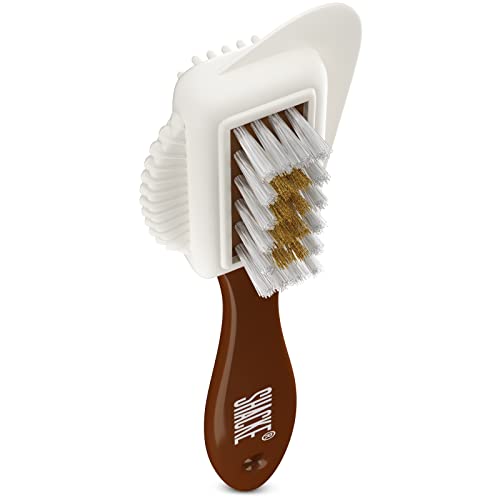Hand sanitizers and sanitizing, in general, have become much more commonplace after the pandemic. We want to keep our health safe, which will involve ensuring that your hands are clean as they touch everything. However, it might become very common to spill or drop some hand sanitizer on your leather purse, jacket or shoes accidentally and it will leave a stain. Here’s how to fix those stains on various types of leather.
Does hand sanitizer damage leather?
Hand sanitizer can indeed damage leather. However, it would take a really long time to do so. Hand sanitizer usually contains alcohol, and since it’s in a gel form, it doesn’t evaporate quickly. This means the alcohol will stay on the leather for longer, interacting with the surface and taking off some color with it.
What can hand sanitizer do to leather?
Hand sanitizer can dry out leather quite quickly because of the alcohol content. The alcohol will penetrate the leather quickly since it will not evaporate due to its gel nature.

Once the alcohol penetrates into the leather, it takes out some dye and the leather’s natural oils with it. This is one of the reasons hand sanitizer can stain leather surfaces.
It can also stain leather by attacking the coating on top of the leather if it has any thick coating on top. This can happen whether the coating is synthetic or natural.
Removing hand sanitizer stains from Real leather
Real or grain leather is a very tough material, but that doesn’t make it impervious to stains. While liquid stains won’t damage or lessen its structural integrity, natural leather is quite susceptible to it, especially if there was no waterproofing done to it.
Leather conditioner
You can never go wrong with leather conditioner, especially for grain leather. As hand sanitizer can leave the spot dry, this will be an effective method to fix it as moisturizing the leather will fix that dry spot. However, leather conditioners alone may not work for dyed leather items.
Things you will need:
- Leather conditioner
- Leather cleaner (optional)
- Clean, dry cloth
- Tissue paper
- Horsehair brush (optional)
- Shoe tree (for shoes)
Steps:
- Remove as much of the sanitizer as you can with a tissue, be careful to not spread it around and make the problem bigger.
- Remove any debris on the surface before rubbing on the conditioner or cleaner to avoid scratches.
- Insert your shoe tree if you’re working on shoes.
- Apply your leather conditioner to the area, concentrating there first before evening it out to the surrounding areas.
- Repeat until the dry spot is saturated and not visible anymore.
- You may use a horsehair brush to buff the surface into a satin shine.
Alcohol
Wouldn’t alcohol make the problem worse? Actually, not really. As was said earlier, liquids don’t really damage the structural integrity of grain leather. In this case, we’re using alcohol to even out the dry spot and hopefully make it invisible.
Disclaimer: This method may lighten the color of your item, please avoid this method if you are not willing to change the color of your item like on uncommon dye colors. Please be careful with leather dyes as they are almost impossible to remove and reverse, only use leather dyes if you have confidence and experience using it.
Things you will need:
- Alcohol
- Clean cloth
- Leather conditioner
- Leather dye (optional)
Steps:
- Remove any dust and debris on your item before applying the alcohol to avoid scratches.
- Damp the clean cloth with alcohol. Do not pour the alcohol directly on the leather.
- Starting from the stain, slowly rub the cloth with alcohol in circular motions, slowly moving outwards.
- Keep blending the edges of the spot until it is no longer distinguishable.
- If your leather item is not dyed or is a light brown, the leather conditioner will suffice to bring it back to its original darker color.
- If your leather item is dyed red or green, you may need to redye the leather if a significant amount of color was removed.
Saphir Juvacuir
Saphir is known for its line of amazing leather shoe products. They have a very comprehensive list of leather care products you need including color correction or changing it altogether.
You will need to proceed with heavy caution, however, as leather colorants are not something you should just use carelessly. Leather colorants can make or break your item, they have the capability to make it look even better, or absolutely horrible. Only do this if you’re confident and have the experience or are willing to learn big lessons.
If your shoes or leather item are black, you don’t really have anything to worry about.
Things you will need:
- Leather Cleaner Renomat Saphir
- Saphir Juvacuir (in the right color you need)
- Clean cotton cloth or polishing cloth
- Water
- Shoe wax (for shoes)
Steps:
- Remove any dust and debris on the item to avoid scratching the leather.
- Remove any grime or dirt with a leather cleaner to prepare it for the color creme.
- After preparing the leather, dampen the polishing or cotton cloth with water. Make sure it’s just damp, not wet.
- Shake the Saphir Juvacuir bottle until the color is even.
- Dip the cloth into the Juvacuir. Don’t take too much, just a little bit will do.
- Dab the cloth onto the affected area, then start to swirl and blend the color.
- Repeat this 3 or 4 more times until the stain is completely gone.
- Apply your shoe wax and buff it with a horsehair brush to achieve a satin shine.
Removing hand sanitizer stains from faux and coated leather
Coated leather isn’t breathable, nor would the hand sanitizer even reach the leather as it won’t be absorbed down to that level. However, the coating may still be stained by the hand sanitizer for a different reason than the bare leather itself. Usually, it’s because of alcohol’s chemical reaction to the plastic.
If you’re dealing with a synthetic material like faux leather or coated leather, this can easily be fixed with oils. You may use WD-40 for this, even. Test in an inconspicuous place of your leather item.
To use WD-40 to fix those stains, simply spray it into a piece of cloth or tissue paper. You can then proceed to rub it on the stain and it will go away almost like magic. However, it may leave the surface oily and sticky. Simply rub the excess off with clean and dry tissue paper until the stickiness is gone.
Some may suggest petroleum jelly, however, we suggest against using this as this can damage and degrade the synthetic material.
You may be able to use it, but don’t leave it for long periods of time and wipe off as much as you can as to not leave any petroleum jelly that can destroy the faux leather quickly.
Removing hand sanitizer stains from suede leather
As long as the liquid is clear, the fix for stains on suede leather is almost always the same.
If you own any suede leather items, it is imperative that you own a suede leather cleaning kit as well. You don’t need much, the most important suede cleaning items are just a suede brush and a suede eraser.
To remove the hand sanitizer stain, you can go with two options; wet or dry.
Wet method
The wet method will involve getting the whole suede item wet to even out the color the stain has made. Since this is hand sanitizer, this will be an effective method as it does not have color and is only a dry spot.
Simply wet the suede item by spraying it with water. You don’t need it soaking wet, but just enough to wet the whole surface evenly. You can let it dry in a cool, dry room and the stain will be gone after it’s dry.
Dry method
The dry method will involve some elbow grease. However, it is the quickest. Simply use the suede brush to even out the fibers. You can even dip the brush in just a tiny bit of water, then keep on brushing to even out the color.
If this method does not work, the wet method will always be a reliable bet.
Conclusion
Stains on your leather items shouldn’t be a reason for you to stop using hand sanitizer. However, it may be better for you to keep a spray bottle of alcohol on you instead of a gel hand sanitizer as the chances of accidents are much less with a spray bottle.
Sometimes, accidents are hard to avoid, though. We hope this article has helped you remove hand sanitizer stains from your leather items.
FAQ:
What happens if you soak leather in alcohol?
Soaking leather in alcohol will quickly strip it of its oils. It won’t exactly damage the leather if it’s made of top-grain or full-grain leather as those are very durable. However, genuine leather and lower-quality leather may become brittle and the fibers may easily break after drying out because of the alcohol.
For grain leather, it is best to follow it up with conditioner afterward to prevent it from becoming stiff and uncomfortable.
How do you remove hand sanitizer from Louis Vuitton?
Louis Vuitton usually has coatings on their leather. To remove hand sanitizer stains from any Louis Vuitton purses or bags, it’s best to use oils like marula oil or coconut oil. You may also use petroleum jelly, but you must remove as much of it as you can with paper towels after application to avoid the material from weakening.
Does hand sanitizer discolor leather?
Hand sanitizer is able to discolor leather by drying it out and fading out the dyes or colorants. This is because the alcohol is concentrated in gel sanitizers and doesn’t evaporate immediately. You can fix this by using recoloring products or leather conditioners.









